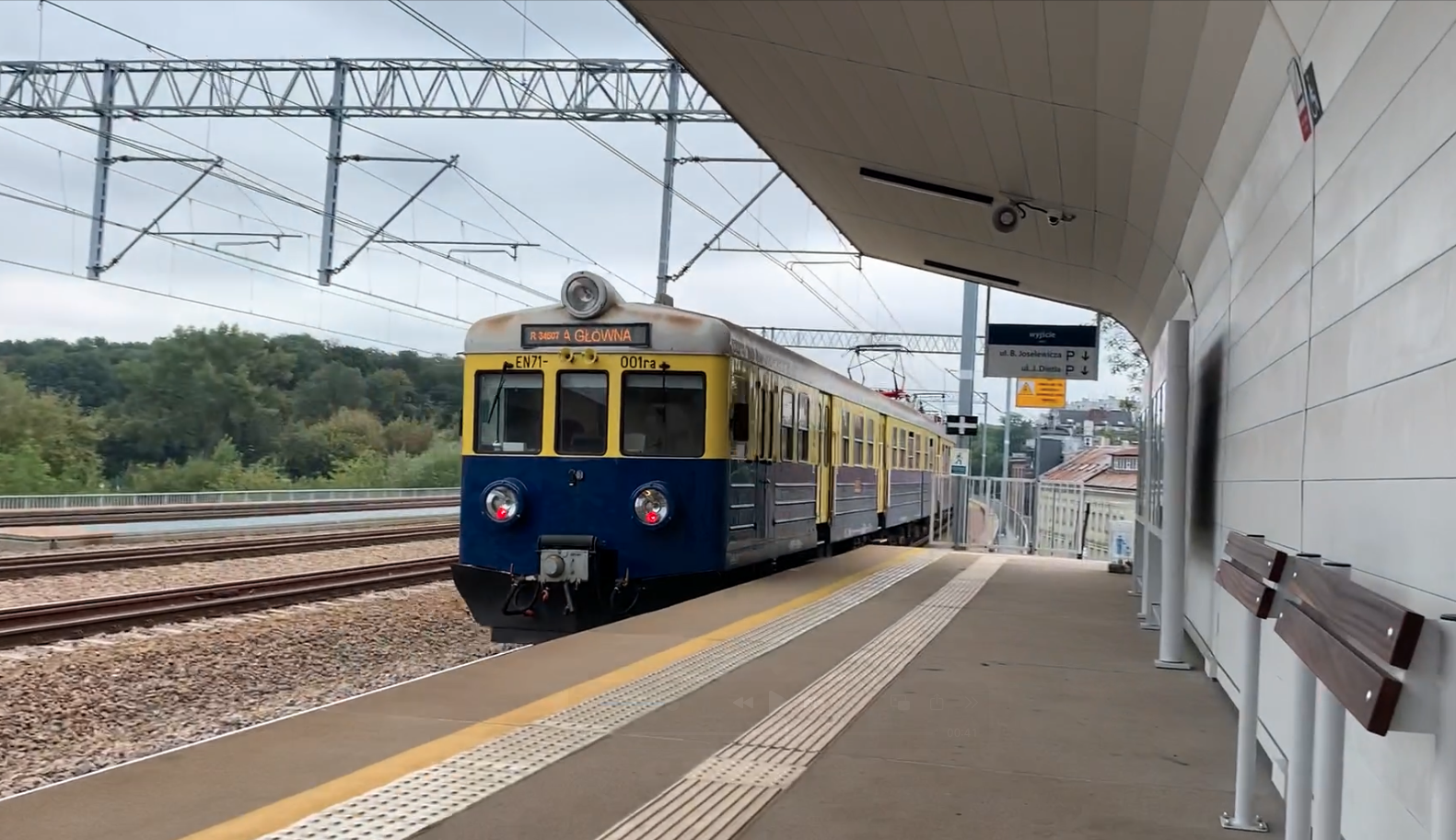Kraków 2025-06-17
EZT EN57, painting.
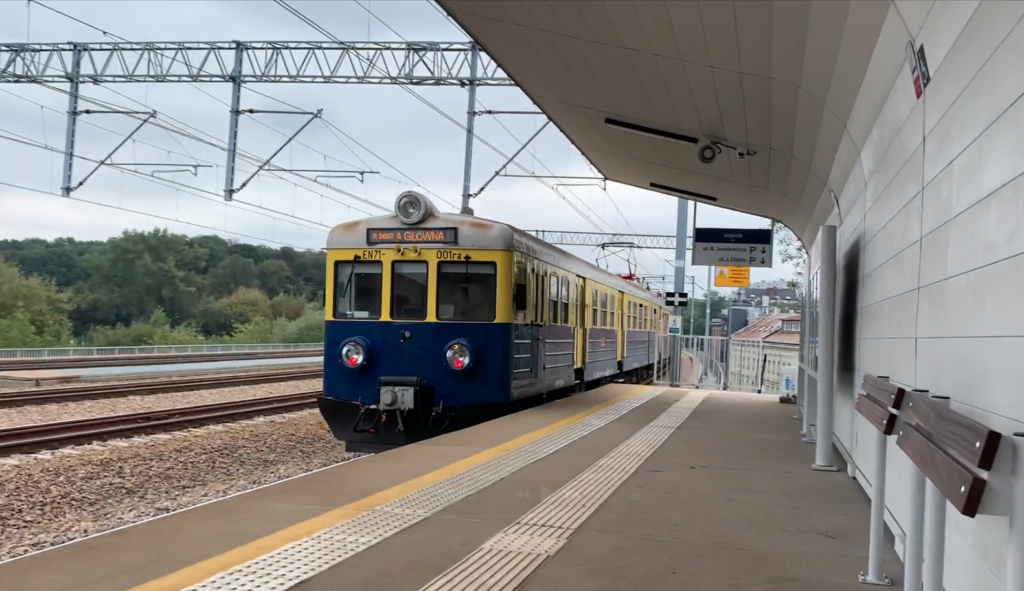
Photo description: EN71-001 is the first EN71 train transferred by the PaFaWag factory in Wrocław, to the PKP state. The train was built in 1976. In 2024, at PESA Mińsk Mazowiecki, the train underwent a P4/5 level repair and the original painting was restored. The train returned to the regular timetable.
The EN57 series Electric Multiple Units are the most numerous series of EZTs in PKP, which could be found in every region of Poland, on electrified routes. Design work on the new EZT passenger train was carried out in the period 1959-1961, in parallel with work on the EZT EW55 train, which was intended for the Warsaw and Gdańsk junctions. That is why the EN57 and EW55 trains are very similar to each other. The letter “N” in the name means a low platform, and the letter “W” means a high platform. The trains differ in the number of pairs of doors in one car and the entrance steps. The documentation was prepared by the Central Design Office of the Rolling Stock Industry in Poznań (currently OBRPS Poznań). The prototype EN57 train made its first run in December 1961. Production was placed in Wrocław at the PaFaWag factory. In the PaFaWag factory, the engine cars were designated type 6B, and the control and shunting cars were designated type 5B. To explain: the EN57 EZT consists of three cars, and each car is based on two bogies. The first and last cars are rolling cars with mechanic’s (driver’s) cabins. The middle car is the driving car; two bogies, and each has two electric motors. The EZT EN57 train is a Polish design that was mass-produced from January 1962 to July 1993, i.e. for 31 years. The EN57 train is the longest-produced rail vehicle in the world. In 2021, it was the 60th anniversary of the construction of the first train, an electric unit. A total of 1,429 units were built. Other sources indicate 1,452 units, including those exported to Yugoslavia and four-car units.
Based on the EZT EN57 train, the “Pafawag” factory also built four-car units with an additional engine unit, which was placed in the middle of the train. These trains were designated EZT EN71. The first such train was built in 1964. These trains were initially built to service the difficult Kraków-Zakopane route. In 1965, Yugoslavia bought trains of this type. Apparently, in Yugoslavia the trains were called “Gomułka” after Władysław Gomułka (First Secretary of the Polish United Workers’ Party), during whose time the trains reached the Balkans.
Generally, it can be said that there were three production series of EN57:
Serial numbers 001 – 130 and 601 – 1 113, which received grooved sides of the cars and three windows in the front wall. The grooved sheets increase the rigidity of the structure, just like stringers in aircraft fuselage structures. Additionally, some trains had a first-class compartment.
Serial numbers 1 114 – 1 825 have smooth sides of the boxes and three windows in the front wall.
Serial numbers 1 900 – 1 953 have smooth sides of the cars and two windows in the front wall, similar to EW58. Additionally, the driver’s cabin equipment is different, because the installed systems are slightly different.
Serial numbers 2001 – 2075 were assigned to trains after modernization according to the SPOT program, i.e. the Sectoral Operational Program Transport.
Serial numbers 3001 – 3010 were assigned to trains that returned from the countries of the former Yugoslavia and were renovated and retrofitted.
Operation of EZT EN57 trains.
In the 80s, central door opening by the driver, and not by the train manager, began to be introduced in ETZ EN57 trains. Additionally, an audible warning signal was introduced when the doors were closing.
In 1993, during modernization, trains were also built that had a separate 1st Class, in the Rb carriage. They had upholstered aircraft seats, curtains in the windows and a sound system. There was also a so-called bar compartment with a stove, sink and refrigerator.
The long years of operation of EZT EN57 trains meant that the owners subjected them to various modifications. As a standard, since 1989, the trains were repainted. The traditional yellow and blue painting was characteristic of the PRL period. That is why the trains were called “yellows”. New carriers paint the trains in their own colors. Currently (2021) the most famous livery in Poland is the livery of the PolRegio carrier.
For the past 90 years, modernization has consisted, among other things, of adapting vehicles for disabled people. The IT system was modified and the sound system was introduced. The heating was improved. Air conditioning was installed in the driver’s cabins and in the passenger compartments. The windows were replaced with double-glazed ones. Compartments for transporting bicycles were introduced.
A major change was the replacement of traction motors with asynchronous motors, which are controlled by an inverter. These motors are more powerful, because each motor has a power of 250 kW. A train with such motors reaches a speed of up to 125 km/h, compared to 90 km/h with the previous 125 kW motors.
At the beginning of the 90s of the 20th century, the PKP company experienced successive crises. A company called InterRegio was established. Its goal was to create fast tourist connections between large urban centers and important tourist and spa towns. The plan was to use, among others, the EN71 EZTs for service. These trains were planned to be modernized. The plan was also to use the modernized EN57 trains. In the Sucha Beskidzka locomotive shed, several EZTs were prepared, distinguished by soft seats and a new, more colorful; red and white paint job. The first InterRegio trains were, among others: “Kasprowy” on the Kraków – Zakopane route and “Giewont” on the Zakopane – Częstochowa route. In Małopolska, the trains “Rysy”, “Janosik”, “Poprad” and “Dunajec” were still running.
In the second half of the 90s, the colorful EN71s were replaced by new units of the ED72 series. This vehicle also stood out with more comfortable seats and a 1st Class compartment. In Lower Silesia and on the SKM, for a long time it was also possible to see EZTs that differed in color from the standard patterns.
Interestingly, many components from scrapped trains are used in new rolling stock. This is the case, for example, with power bogies. Also, frames and box skeletons are used. Sometimes, trains built on such a basis still have the EN57 designation, but very high serial numbers. Others received a completely new designation, and their appearance does not reveal their origin from EN57. This was the case, for example, with the NEWAG 14WE trains, of which 9 were built in the period 2005–2009.
As part of the SPOT program (Sectoral Operational Program Transport) in the period 2006–2007, 75 EZT EN57 trains were modernized and assigned serial numbers 2001–2075.
An anti-theft system with motion detectors and 16 cameras were installed in the modernized trains, the preview of which is visible on the screen in the driver’s cabin and which constantly monitor the interior of the vehicle and have a record on memory cards.
In 2007, several trains were modernized for SKM Trójmiasto and Koleje Mazowieckie to the EN57 KM version, where the electrical systems were significantly improved, including changing the resistance start to impulse start.
In 2008, Koleje Mazowieckie ordered the modernization of 10 trains to the EN57 AKM version. The trains were fitted with LK450X6 AC (asynchronous) engines, developed by EMIT from Żychlin. The new engine has a power of 250 kW, and the entire train has a power of 1 MW, which significantly improved the traction parameters of the vehicles. Acceleration increased and the maximum speed was raised to 125 km/h.
Other local governments, such as the Łódź and Wielkopolska provinces, also decided to modernize their EZT EN57 trains. The modernization was carried out individually for each entity. That is why the trains received very different additional letter markings. Mainly, the engines were replaced with asynchronous ones. New passenger seats and wall coverings were installed. Closed system toilets and toilets for disabled people were installed. Driver’s cabins were replaced, new train fronts and air conditioning were installed. External doors were replaced with step-sliding, which are more sealed. Ticket machines and vending machines for drinks and sweets were installed.
In September 2017, the carrier PolRegio received the first deeply modernized EN57-2205 train. The train is no longer similar to the classic EN57, although it has the EN57ALc marking. A total of 36 units were rebuilt. These trains have already undergone a second level P5 renovation. The renovation was carried out at the ZNTK plant in Mińsk Mazowiecki, which belongs to the PESA group. The modernized trains have a single-space interior along their entire length and are equipped with air conditioning. The seats are aircraft-style, well-upholstered and comfortable. There is also Wi-Fi for passengers and 230 V sockets. Each train has two closed-system toilets, one of which is for the disabled and has a baby changing table. The toilets also have electric hand dryers.
In 2017, the EN57-001 train stationed in Przeworsk was placed under the protection of the conservator of monuments and will not be scrapped. It is an important exhibit in the history of the Polish Railways.
EN57 train painting.
Yellow-blue painting.
Initially, all EN57s were painted yellow-blue. The window line was yellow, and the lower part of the car body was blue. The doors were always yellow, which made it easier for passengers to orient themselves as to the location of the doors. While the yellow color was always one shade, the blue color changed. Initially, it was light blue (EN57). Later, it was blue, and even dark blue (the first EN71). In the 1960s, the paints were of worse quality than today. The paints of that time tended to lose color due to fading. Therefore, the dark color became lighter over time.
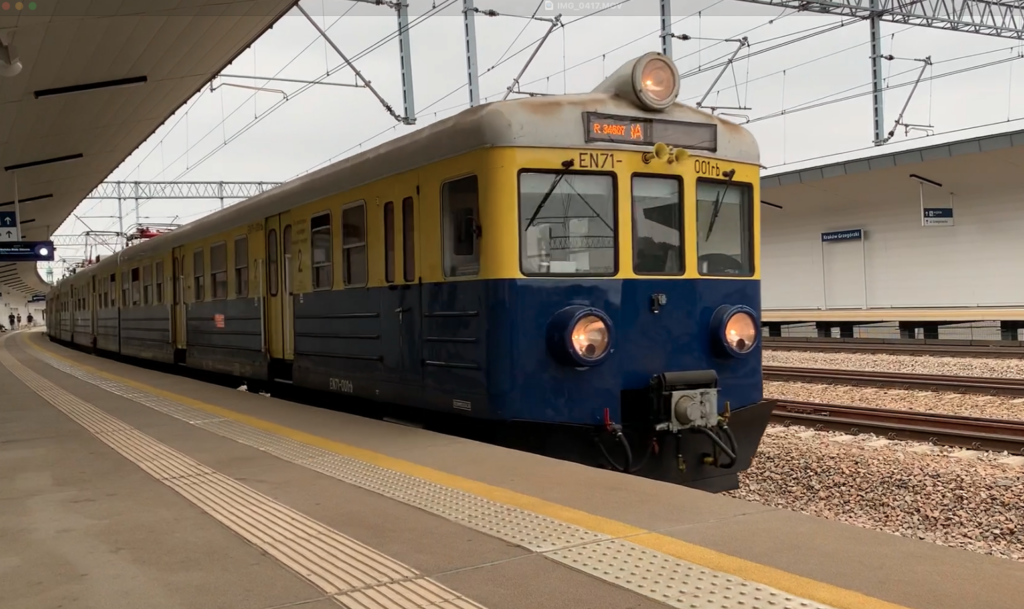

Photo description: EN71-009 was built in 1976. It was used in the following locomotive depots: Sucha Beskidzka, Kraków, Bydgoszcz, Kielce, Gdynia. In 2009, the train was repainted in grey-burgundy. In 2013, the train was repainted in Pomeranian colours; light blue with a yellow stripe at the height of the windows and another narrow one below. In 2019, the train ended its service life and was transported to Chojnice. In 2024, the train was scrapped.
Orange livery.
The orange livery initially appeared in the Warsaw railway junction. It could also be found in other places: Olsztyn, Lublin.
Yellow-diagonal-blue livery.
Yellow-diagonal-blue livery, yellow-blue front walls, yellow-blue doors. This is a typical livery for the Fast Urban Railway in the Tri-City, i.e. SKM Trójmiasto.
Cream-diagonal-red livery.
Cream-diagonal-red livery, front walls all red. This was the livery of some EN57 type EZTs in the Olsztyn junction. It is no longer used.
Burgundy-cream livery.
Burgundy-cream livery, yellow inserts on the front walls. There were several such EN57 trains in the Łódź junction. They were repainted relatively quickly. This livery is no longer used.
Blue-yellow livery.
Blue-yellow livery, characteristic yellow zigzag at the ends of the train. The livery pattern was a reversal of the standard yellow-blue livery. This livery pattern was used in several regions of Poland and aspired to be the standard livery after the yellow-blue livery.
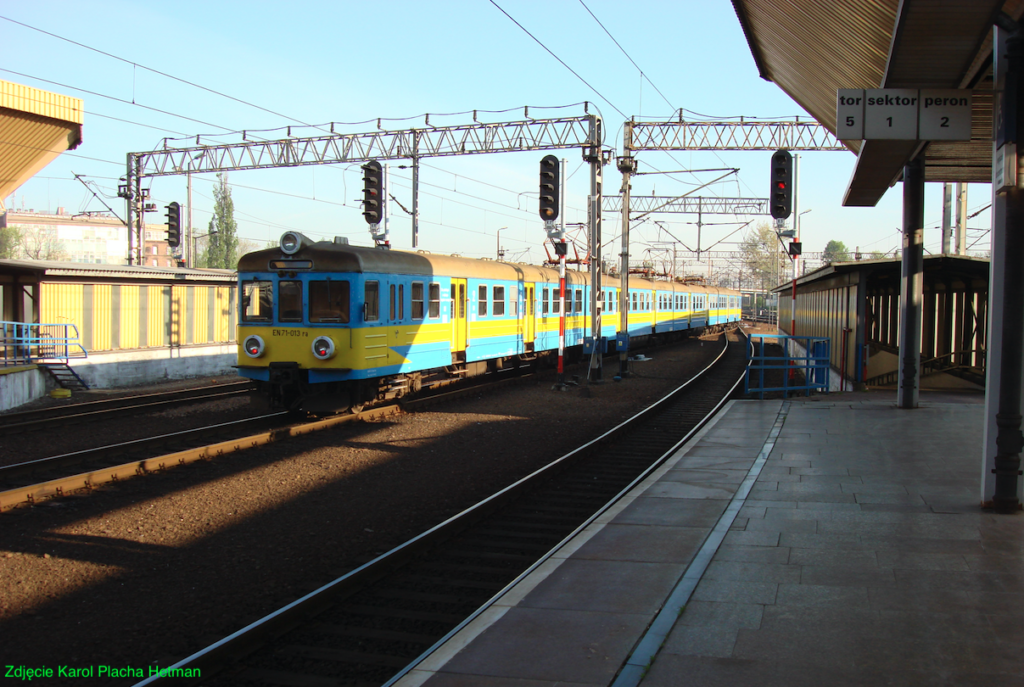
Photo description: The train was built in 1976. The train was used in the following locomotive depots: Sucha Beskidzka, Kraków. In 2005, the train was repainted in blue and yellow. In 2010, the train was repainted in a standard gray and burgundy. The train was used until 2017.
Orange livery with a burgundy stripe.
The orange livery with a burgundy stripe was used on several EN57 EZTs, in the Toruń junction. Currently, there is no such livery.
Orange-burgundy paint.
Orange-burgundy paint was used on several EN57 EZTs in the Szczecin junction. Currently not present.
Red paint with a yellow stripe.
Red paint with a yellow stripe and a zigzag in the front. Yellow doors. Only a few EZTs that were used in the Bydgoszcz junction received it. Currently not present.
Dark blue-cream paint.
Dark blue-cream paint, front walls and red doors. They could be found in the Katowice junction. Only a few EZTs were painted like this. This paint is often called “Karolinka”. Currently not present.
Burgundy-cream paint.
Several EZTs in the Katowice, Szczecin and Warsaw junctions received the EZT-colored burgundy-cream paint. The EZTs painted like this were called deLux, because they often had 1st Class.
Cream-diagonal-red livery.
Cream-diagonal-red livery, cream-red front walls. Livery of InterRegio trains. Currently not used.
Gray livery.
Gray livery, orange doors. Several EN57 trains received this livery. Including trains operated by the Świętokrzyskie Voivodeship. Repairs and livery were carried out by the Rail Vehicle Factory in Poznań.
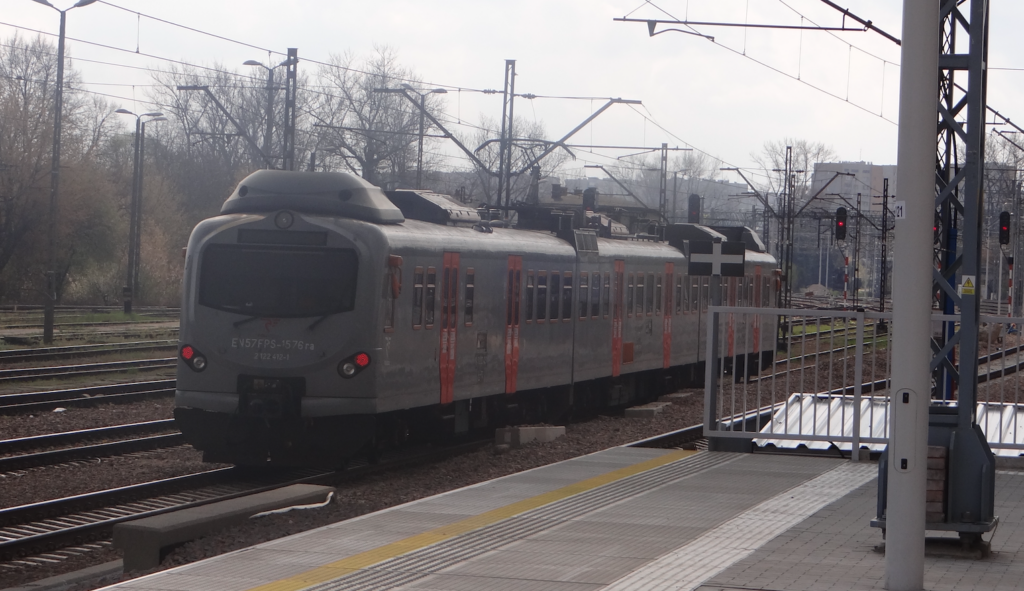
Green-cream-yellow livery. Koleje Mazowieckie.
Green-cream-yellow paint, colorful suns and road as patterns, yellow doors. This is the new paint scheme of EZTs belonging to Koleje Mazowieckie. This paint scheme is used by all other and new EZTs used in Koleje Mazowieckie.
Gray-burgundy paint scheme.
Gray-burgundy paint scheme was the new paint scheme for all EZTs of the EN57 and EN71 type, in all Regional Transport Plants. The EN57-200X EZT paint scheme was adopted as the standard. Burgundy roof, cream stripe above windows (or gold 1st Class), gray stripe of windows, cream stripe below windows, burgundy bottom, cream stripe of underframe. Gray doors. Cream handles (handrails) by doors. New fabric upholstered seats installed in the 1st Class compartment, arranged 3 in a row.
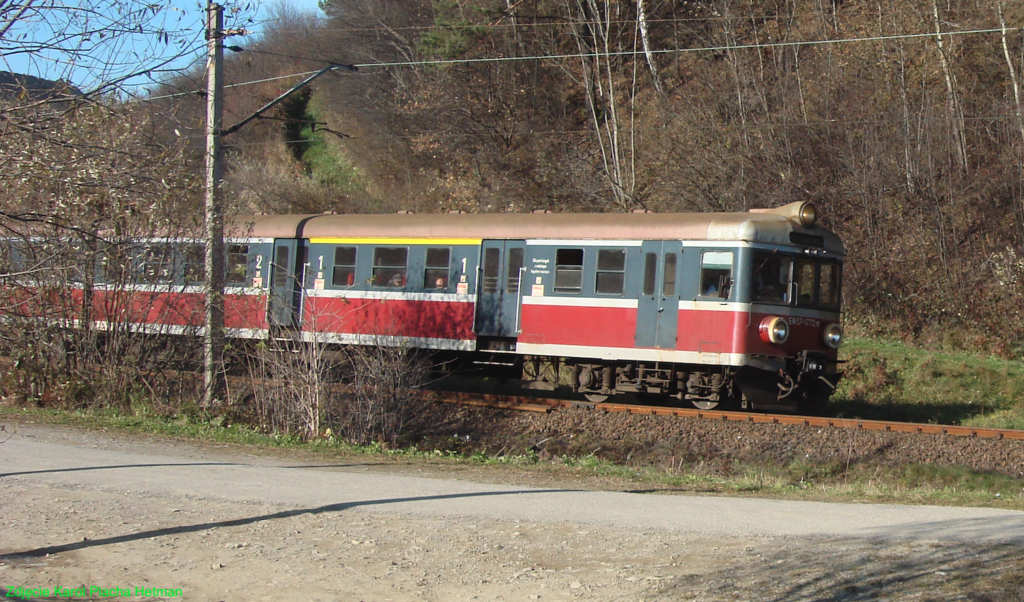
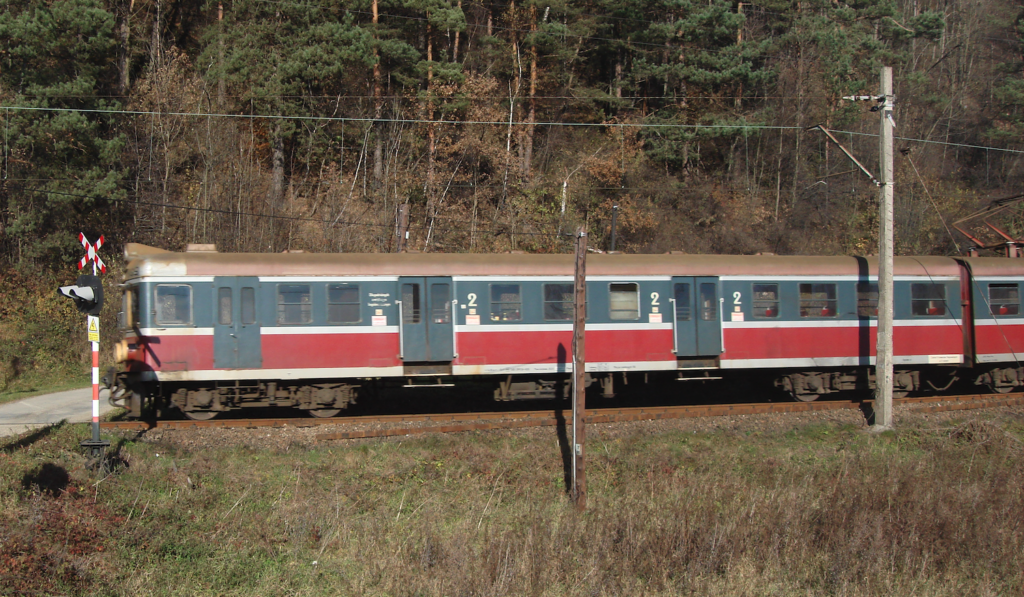
“Tiger” livery.
In 2014, the Regional Transport management decided on a new livery pattern for its EN57 and EN71 EZT trains. In 2016, the new livery pattern was also introduced for regular passenger cars. It was planned to repaint 18 cars and 5 locomotives. 33 million from the European Union was obtained for the vehicle renovation and repainting program, out of 56 million total costs.
The first newly painted vehicle was EZT EN57AL. The new livery was applied during the modernization, which was carried out at ZNTK Mińsk Mazowiecki. In the first year, 21 EZTs were repainted. EZT trains were operated in the railway junction; Poznań, Wrocław, Wałbrzych, Jelenia Góra, Kraków. The plan was to repaint the remaining EZTs without repairing them.
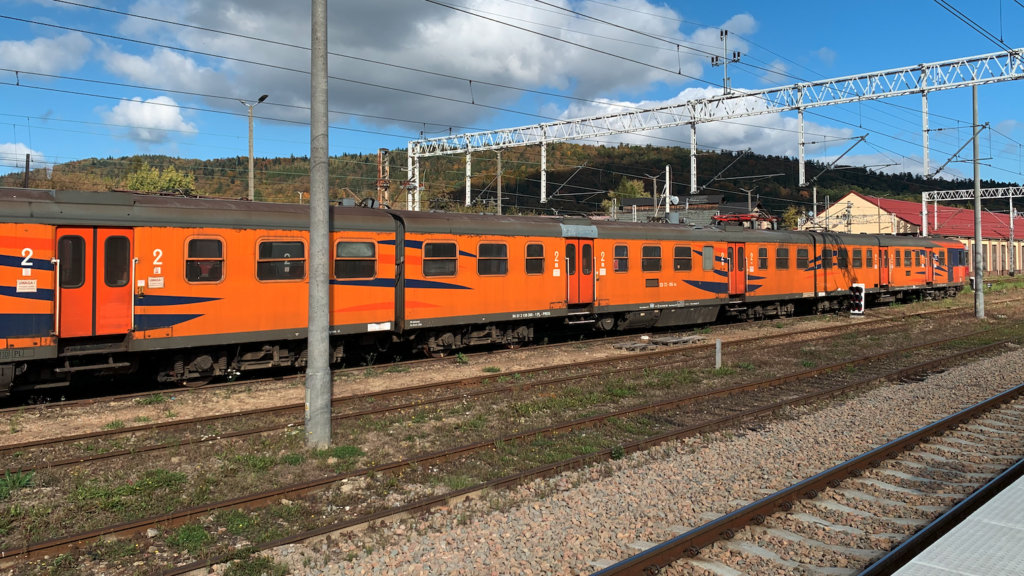
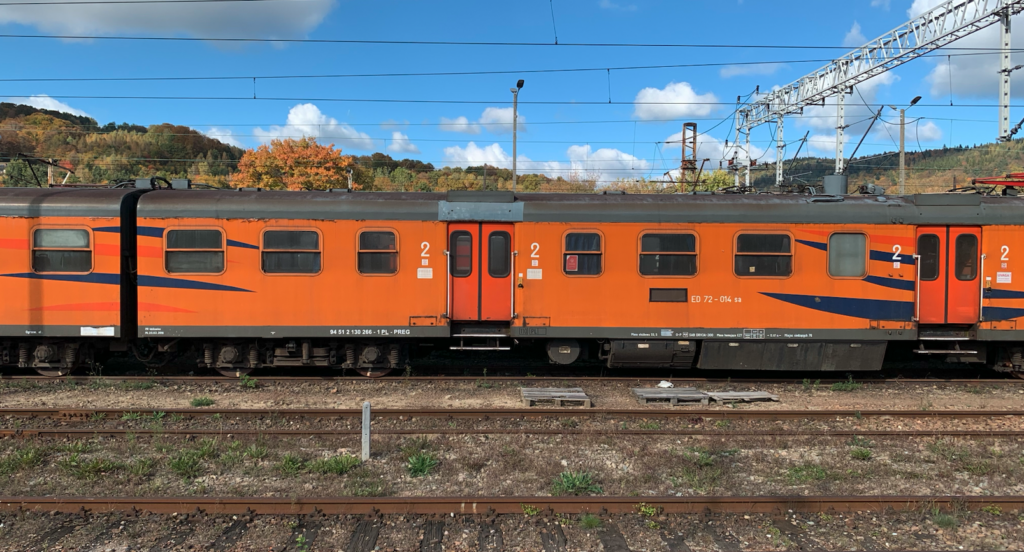
Painting red, orange, gray and silver.
Less than 2 years later, significant organizational changes took place (December 2016). Przewozy Regionalne changed the name of the transport brand to PolRegio. The new train paint scheme reflects the change in the operator’s identification. The first vehicle to gain the new PolRegio colors was the EP07P-2002 locomotive. The first EZT to receive the new colors was EN57-2008. The train was painted at ZNTK Mińsk Mazowiecki during the P4 level inspection. Repainting of all vehicles was planned for a period of 30 months. New vehicles were ordered in the new paint scheme. In the first 12 months, approximately 50 EZTs were repainted, without renovation, and an additional 80 EZTs during the P4 level inspection.
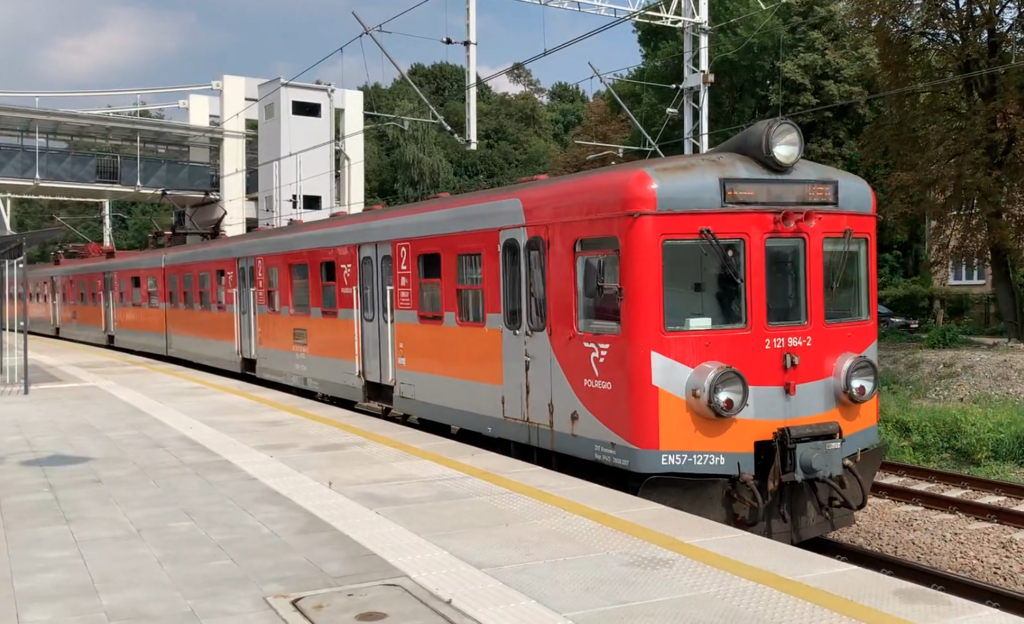
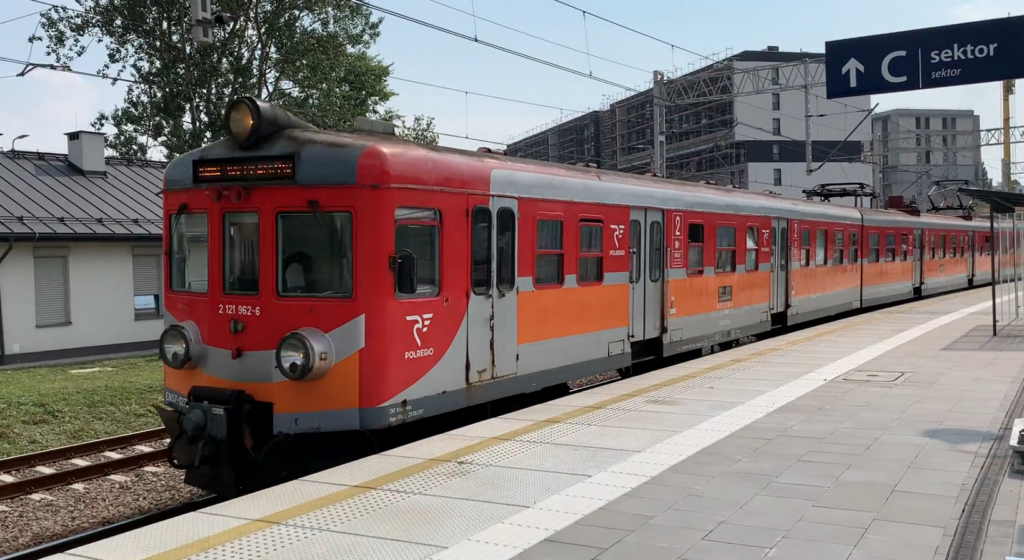
Written by Karol Placha Hetman
